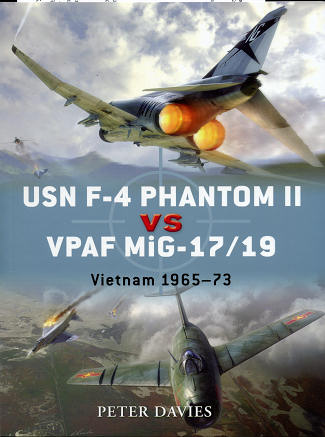 Osprey's
Duel #23 covers two of my favorite jet aircraft types, the F-4 Phantom II and
the MiG-17 as well as the larger and faster MiG-19. These very dissimilar types
met each other in the skies over North Vietnam during the Vietnam war. The
Phantom II was a supersonic fleet interceptor, armed with missiles and designed
to knock enemy bombers out of the air at the limits of visual identification.
The MiG-17 was a rugged, low tech fighter armed with three cannon. All the
training and experience were on the side of the Navy Phantom IIs. All the desire
to defend their homeland and a knowledge that the US planes would be flying
predictable routes were on the side of the MiG pilots.
Osprey's
Duel #23 covers two of my favorite jet aircraft types, the F-4 Phantom II and
the MiG-17 as well as the larger and faster MiG-19. These very dissimilar types
met each other in the skies over North Vietnam during the Vietnam war. The
Phantom II was a supersonic fleet interceptor, armed with missiles and designed
to knock enemy bombers out of the air at the limits of visual identification.
The MiG-17 was a rugged, low tech fighter armed with three cannon. All the
training and experience were on the side of the Navy Phantom IIs. All the desire
to defend their homeland and a knowledge that the US planes would be flying
predictable routes were on the side of the MiG pilots.
Vietnam was a very frustrating war for US pilots. Politically
limited in when they could be used offensively as well as restricted as to the
routes taken into those few targets they could attack fairly well hamstrung
them. When one combines this with the unreliability of their main armament
(Sidewinder and Sparrow missiles), the lack of a gun, and the lack of ACM
training, and it is not amazing that the kill/loss ratio in the early days was 1
to 1.
Fortunately, the Navy learned from this and not only started
to emphasize ACM training, but developed Top Gun, the NFWS, to really hone the
skills of as many pilots as it could. It is telling that after Top Gun was
started, only one graduate crew was ever shot down. The Navy also adopted a more
freeflowing combat pair that also reduced losses, while the USAF stuck with a
less flexible four plane formation. Combining that with the lack of proper
dissimilar ACM training meant that the USAF had a much higher kill/loss ration
while the Navy's was almost one sided in their favor.
In this book, author Peter Davies covers the development and
deployment of both the Phantom and the MiGs. It has a good look at the training
and capabilities of their respective pilots as well as how they performed in
combat. It also weighs in on how the tactical and strategic situation affected
the two sides and their approach to combat situations.
In all, it is, in this reviewer's opinion, one of the best of
an already superb series. If you want to read about what it was like during that
time, then this is a book you simply must pick up.
November 2009
For more on the complete line of Osprey books,
visit www.ospreypublishing.com. In the US, it is
Osprey Direct at 44-02 23rd St, Suite 219, Long Island City, NY 11101., where you can
get a catalogue of available books.
If you would like your product reviewed fairly and quickly, please contact
me or see other details in the Note to
Contributors.
 Osprey's
Duel #23 covers two of my favorite jet aircraft types, the F-4 Phantom II and
the MiG-17 as well as the larger and faster MiG-19. These very dissimilar types
met each other in the skies over North Vietnam during the Vietnam war. The
Phantom II was a supersonic fleet interceptor, armed with missiles and designed
to knock enemy bombers out of the air at the limits of visual identification.
The MiG-17 was a rugged, low tech fighter armed with three cannon. All the
training and experience were on the side of the Navy Phantom IIs. All the desire
to defend their homeland and a knowledge that the US planes would be flying
predictable routes were on the side of the MiG pilots.
Osprey's
Duel #23 covers two of my favorite jet aircraft types, the F-4 Phantom II and
the MiG-17 as well as the larger and faster MiG-19. These very dissimilar types
met each other in the skies over North Vietnam during the Vietnam war. The
Phantom II was a supersonic fleet interceptor, armed with missiles and designed
to knock enemy bombers out of the air at the limits of visual identification.
The MiG-17 was a rugged, low tech fighter armed with three cannon. All the
training and experience were on the side of the Navy Phantom IIs. All the desire
to defend their homeland and a knowledge that the US planes would be flying
predictable routes were on the side of the MiG pilots.